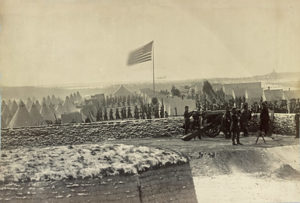
Connecticut legally outlawed slavery in 1848 and in the ensuing decades like the rest of New England largely supported the national abolition of slavery. Prominent abolitionists such as Harriet Beecher Stowe, Horace Bushnell and Norwich native Prudence Crandall were vigorous and outspoken opponents of this heinous institution.
The state had supported the unsuccessful bid of Republican presidential candidate John C. Fremont in 1856 and the party’s platform opposing the expansion of slavery in the western territories of the United States. In 1860 Connecticut voters overwhelmingly supported the successful election of presidential candidate Abraham Lincoln. Norwich native, Republican William Buckingham was also narrowly elected governor of the state that same year.
A few days after the bombardment of Fort Sumter in South Carolina in April 1861, Governor Buckingham heeded President Lincoln’s call for citizen volunteers to join the Union war effort. Buckingham issued a state-wide proclamation to the state’s male citizens to enlist in locally formed infantry regiments and artillery batteries. In the months that followed, thirty infantry regiments were formed in the state including two regiments of black soldiers. Two regiments of heavy artillery were also created in support of the Union war effort. Fort Trumbull in New London served as the local Union headquarters and training grounds for new recruits.
Military manufacturers like the New Haven Arms Company and Colt’s Manufacturing Company in Hartford played a prominent role in supplying arms for the Union troops during the war. The Norwich Arms Company secured several lucrative federal contracts and expanded armaments manufacturing at its factory producing 1,200 muskets and 3,000 bayonets per week. Shipyards in Mystic, Connecticut provided ships for the Union Navy.
Casualties to Connecticut military personnel during the entirety of the war numbered 1,094 enlisted men killed in action with another 3,000 dying from disease. Deaths of 97 military officers were recorded with another 400 men reported as missing.
To view photographs of Connecticut in the Civil War and the official rolls of the Norwich infantry regiments and military officers visit the Otis Library’s Flickr site of historical photographs.
